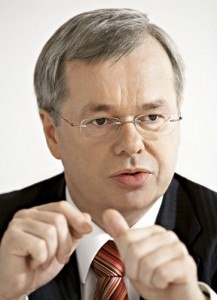With catastrophe excess-of-loss reinsurance premiums making up less that less than 10 percent of its overall portfolio, the influx of capital from institutional investors into the reinsurance market is not a serious threat to Munich Re, a company representative said.
 Speaking at a press conference during the Rendez-Vous de Septembre in Monte Carlo on Sunday, Torsten Jeworrek, a member of the board of management for Munich Re, also suggested that insurance-linked securities transactions may not be modeled as rigorously as those placed in the traditional reinsurance market.
Speaking at a press conference during the Rendez-Vous de Septembre in Monte Carlo on Sunday, Torsten Jeworrek, a member of the board of management for Munich Re, also suggested that insurance-linked securities transactions may not be modeled as rigorously as those placed in the traditional reinsurance market.
In addition, he voiced some concerns about emerging broker facilities in the large-risk insurance market, suggesting that facilities like one launched by Aon Benfield and Berkshire-Hathaway earlier this year, could herald a return to the soft market environment of the late 1990s.
First, speaking about the capacity coming from institutional investors to the catastrophe reinsurance segment, estimated at roughly $44 billion or 17 percent of worldwide catastrophe excess-of-loss capacity in 2012, Jeworrek noted that Munich projects this will grow to $75 billion—or 25 percent of the market—by 2016.
But cat excess-of-loss reinsurance makes up only a small portion of Munich Re’s overall property/casualty reinsurance portfolio, accounting for 1.5 billion euros out of a total portfolio of 17.0 billion euros.
“So we have to look seriously into that development,” he said, referring to the growth of uptick in institutional investor participation, “but it is by far the lowest share of the Munich Re portfolio, ” he continued.
“That means even further price decline[s] due to new capacity means only a marginal impact on the Munich Re p/c portfolio,” he said, adding that this “picture is probably true for all well diversified reinsurers.”
“So in general, we have a concern. We take a very serious approach, particularly when the new capacity undermines current price levels. But on the other hand, the general impact is manageable and one should not exaggerate here,” he said.
Discussing the price competition in more detail, Jeworrek explained first that there is no particular structural advantage for the new capacity, but then went on to suggest that there is a difference in how catastrophe risk is being modeled in the traditional reinsurance and alternative markets.
He noted that while institutional investors usually have a lower return requirements—charging 5.5-6.5 percent of the capital they have to allocate—unlike reinsurers, institutional investors must allocate 100 percent of the capacity they provide. “That is collateralized reinsurance. They cannot further diversify the capacity they provide. So when they want to provide $100 million limit for a cedent, they have to allocate $100 million on a collateralized basis. So 6 percent times $100 million.”
While reinsurers might price to a return of 12 percent or so, reinsurers can diversify. “When we provide $100 million limit, we do not allocate $100 million of capital. [It] may be 12 percent return requirement times maybe a 35 or 40 percent capital allocation, [which] comes to an overall return of 5 percent, 6 percent or 6.5 percent.”
“The outcome of these different pricing equations is pretty comparable. So that is not concerning,” he said.
Still, “prices from the institutional investors came down to the current reinsurance levels; in some cases, they are already below our levels.”
“So why is that capital cheaper at the end of the day? How can they be more competitive?”
Jeworrek said, “We found out—particularly in the U.S.—that most of these ILS transactions, which were placed with institutional investors, were modeled by the cheapest model in the market.”
“I don’t say that is wrong; I just say that is very different from what we see in the reinsurance market, where all the reinsurers either take their models or build their own opinion of what the model is right in [each] region of the United States.”
“Here we see a more general trend where those transactions that go to the capital markets are priced on the basis of the cheapest model,” he said. “We have to educate the market a bit that model comparison is an issue.”
There’s a similar pricing equation in both markets, but the nontraditional market comes to a different conclusion by using the cheapest model. “And that would be a concern for us,” he concluded.
Addressing the question of the sustainability of capital markets, Jeworrek first said the question is not yet answerable because the ILS capacity has never really been tested by large cat events, and because it is unclear how this market will react as interest rates rise.
He added, however, that “in the past, when we saw big loss events, there’s a sort of “cleansing of capacity” in traditional insurance and reinsurance markets. “It’s most likely that will happen here too” with capital markets capacity. “That means the more qualified players, who understand the risk in the business will stay in the market; others might leave,” he said.
Jeworrek also focused a portion of his presentation on emerging broker arrangements for placing large primary insurance risks in the subscription market, like one in which Aon Benfield is automatically ceding 7.5 percent of risks its places with Berkshire Hathaway—without Berkshire participating in underwriting the risks.
“The broker has the capacity already in its hand. They make use of it. They have it already before they know what the final terms of the leader are.”
Listing potential problems for others in the market, Jeworrek noted that some following insurance companies will likely be replaced.
For Munich Re, however, “our biggest concern” is that the brokers “make use of capacity, but don’t have skin in the game,” he said, noting that the idea is not entirely new. “In the 1990s, these facilities were a soft market instrument,” he said, referring to arrangements in which managing general agents also did not share underwriting risk that ultimately became problematic for insurers and reinsurers.
“It remains to be seen if this is similar,” he said.
“It’s surprising that this capacity came into market at the time when the market was softening a bit and was under pressure—and we remain a bit concerned whether we fall into the traps of the 90s or whether this time the participating companies [will] do… a better job.”
Jeworrek noted that questions of underwriting control and data quality “could probably be solved,” noting that if they are, “there is in theory [a possibility] that these facilities could improve the expenses in the whole value chain. These facilities are cheaper because there’s no reunderwriting involved,” he noted.
“What we have seen so far, however, is that the broker gets an additional commission and does not pass these savings on to the client,” he said.
In summary, referring to both the broker facilities and the new capacity from institutional investors, Jeworreck said companies like Munich Re can better position themselves to face the challenges posed by both developments by providing individual solutions to clients.
“All these capacities are…commoditized,” he said. “They are done with standard models or without own underwriting.”
In contrast, Munich Re is working on developing catastrophe models for new territories, such as China and emerging markets, and is working on structuring individual solutions for clients, such as capital relief transactions, as well as providing claims services.
“This is true of Munich Re, and we also think that should be true for the market,” he concluded.
Willis Re: Third-Party Re Capital Producing More Direct Insurance Competitors
Separately, at Willis Re’s press conference, the broker said the influx of third-party capital into the reinsurance market may displace up to $40 billion of traditional equity capital, which could either be returned to shareholders or redeployed elsewhere in the insurance and reinsurance market.
Giving a higher projection of future growth, panelists at the Willis Re Monte Carlo Rendez-Vous Press Conference said the current trajectory of growth in third-party capital suggests it could account for up to 30 percent of the global property- catastrophe reinsurance market within a few years, representing approximately $100 billion of capacity, according to a press statement about the conference.
The press statement by reinsurance arm of Willis Group Holdings plc referenced the remarks of John Cavanagh, CEO of Willis Re, who noted that discussions so far have centered on the effect third-party capital is having on rates in the property-catastrophe reinsurance market.
Suggesting different consequences of an influx of $100 billion of third-party capital, he said that as the capital enters “it is going to crowd out conventional equity capital. That equity capital has to go somewhere.”
Even allowing for significant returns of capital to shareholders, there could be as much as $20 billion excess equity capital to be deployed, he said.
“You could think of this as being the equivalent of 10 well capitalized startup companies, and the effect on the marketplace would be profound. If capital is redeployed, much of it could go into direct insurance businesses. Many of the hybrid specialty reinsurers are already implicitly going down this path,” he said.




















 Former MLB Player Charged With Insurance Fraud in Florida
Former MLB Player Charged With Insurance Fraud in Florida  AI-Powered Insurance Product Development Is Going to Take Some Powering Through
AI-Powered Insurance Product Development Is Going to Take Some Powering Through  Ford Recall of 43,000 SUVs Due to Fire Risk Won’t Remedy Gas Leaks
Ford Recall of 43,000 SUVs Due to Fire Risk Won’t Remedy Gas Leaks  That Insurance Talent Crisis? It’s a Global Knowledge Opportunity
That Insurance Talent Crisis? It’s a Global Knowledge Opportunity 



